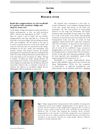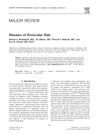Case Series: Gene Expression Analysis in Canine Vogt-Koyanagi-Harada/Uveodermatologic Syndrome and Vitiligo Reveals Conserved Immunopathogenesis Pathways Between Dog and Human Autoimmune Pigmentary Disorders
December 2020
in “
Frontiers in Immunology
”
Vogt-Koyanagi-Harada syndrome vitiligo autoimmune pigmentary disorders T cell gene signatures IFNG TNF PRF1 IL15 CTSW CXCL10 CCL5 FOXP3 TBX21 IGFBP5 FOXO1 PECAM1 TGFB3 SFRP2 CXCL7 VKH T cells interferon gamma tumor necrosis factor perforin interleukin 15 cathepsin W C-X-C motif chemokine ligand 10 C-C motif chemokine ligand 5 forkhead box P3 T-box transcription factor TBX21 insulin-like growth factor-binding protein 5 forkhead box O1 platelet endothelial cell adhesion molecule transforming growth factor beta 3 secreted frizzled-related protein 2 C-X-C motif chemokine ligand 7
TLDR The immune processes causing VKH and vitiligo are similar in dogs and humans.
This study analyzed gene expression in 2 canines with Vogt-Koyanagi-Harada syndrome (VKH) and 1 with vitiligo to explore the immunopathogenesis of these autoimmune pigmentary disorders. The research found that T cell gene signatures, including IFNG, TNF, PRF1, IL15, CTSW, CXCL10, and CCL5, were upregulated in affected dogs compared to healthy controls, mirroring findings in humans. Additionally, genes such as FOXP3 and TBX21 were enriched, while IGFBP5, FOXO1, and PECAM1 were decreased. The study also identified TGFB3, SFRP2, and CXCL7 as potential contributors to these disorders. These findings suggested that the immunopathogenesis of VKH and vitiligo is conserved between dogs and humans, providing insights that could aid in developing targeted therapies and predicting treatment responses.





